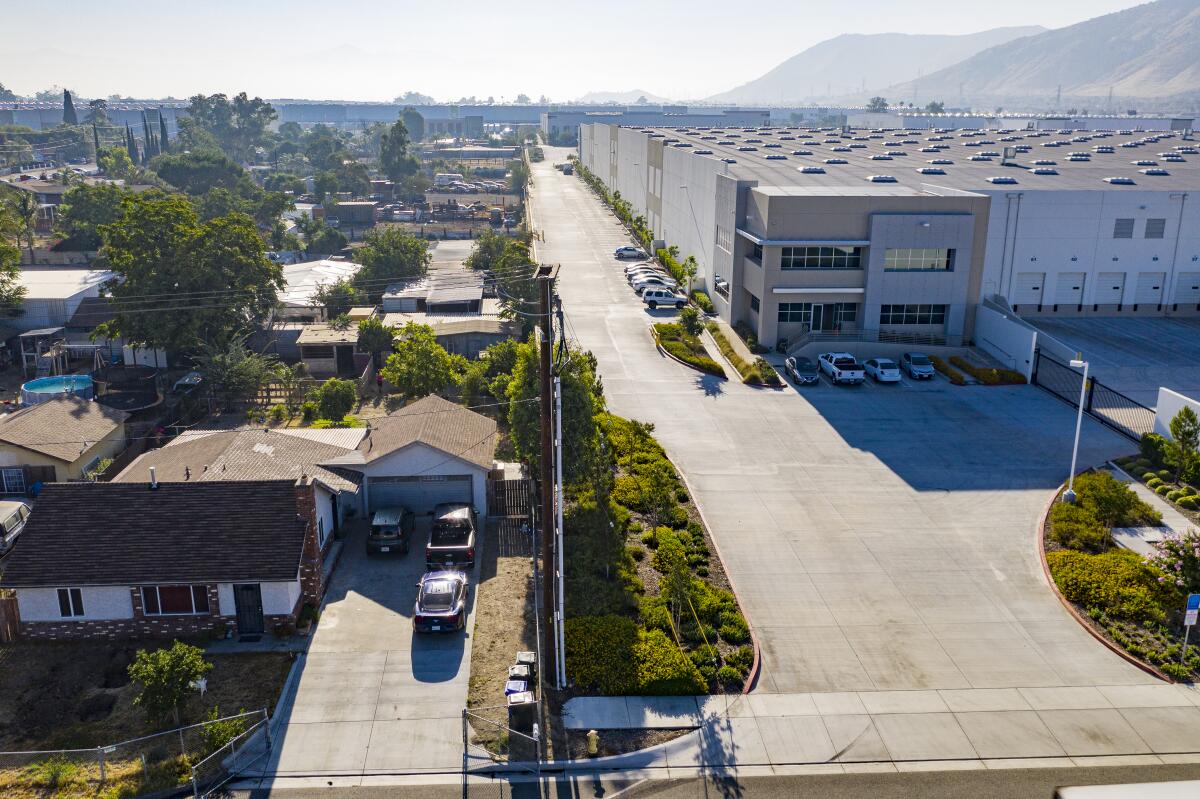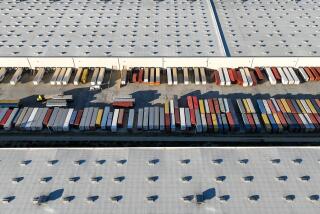Efforts to rein in the Inland Empire’s warehouse industry fall flat

Two years ago, Riverside County Supervisor Kevin Jeffries looked around the Inland Empire and saw massive warehouses inching closer and closer to communities.
The region’s local governments, he said, were receiving the projects with open arms and little real consideration for their health and quality of life impacts.
“They’re pretty much welcomed out here. ‘Come on out bring us the jobs, bring us the property tax revenue and all that’s fine,’” said Jeffries, a former Republican assemblyman. But “nobody wants to talk about the impact that the tractor trailer rigs are having on health and the immediate residents around it. Nobody wants to talk about it and it’s a conversation that’s long overdue.”
Jeffries pushed for the county to adopt a “Good Neighbor Policy” of minimum standards for warehouse projects, including a 1,000-foot buffer between large warehouses and homes.
The county approved the Good Neighbor Policy last month. But it had been gutted, Jeffries said. He voted no.
“We blew it,” he said. “The standards that were adopted are really no standards at all.”
In the last decade, more than 150 million square feet of industrial space, the vast majority of it warehouses, has been built in the Inland Empire, according to real estate services company CBRE.
The boom has brought warehouse projects closer to homes and communities. Some facilities have been built 100 feet or less from residential property lines, despite warnings from state air quality officials, who recommend against people living that close to warehouses because of truck pollution.
City and county officials have generally welcomed the industry, saying warehouses bring desperately needed jobs. And industry advocates say existing guidelines, including under the California Environmental Quality Act, already adequately balance the needs of developers with those of local communities.
Those arguments have largely won the day. Efforts to impose broad standards on warehouse development, or limits on individual projects, have struggled to gain traction, frustrating those who think more needs to be done to protect people from air pollution, noise and traffic.
“At the local level, we need some elected officials that are a little more courageous and are willing to fight for the residents,” said Sen. Connie Leyva (D-Chino), who says her district has more warehouses than any other place in the country. “There seems to be a real lack of concern for the constituents that they represent.”
In San Bernardino, where federal officials are considering a massive new airport logistics center whose tenant has long been rumored to be Amazon.com Inc., advocates for months have said that not enough was being done to address environmental and quality of life issues that were identified during the project’s environmental review.
They have urged the project’s developer, Hillwood Enterprises, to adopt a “community benefits agreement” that would guarantee measures to limit noise and air pollution from trucks as well as job protections for nearby residents. But those efforts have gone largely ignored, advocates said.
Representatives for Hillwood and Amazon declined to comment. Earlier this year an airport official told The Times there was no signed agreement with an end user for the airport facility.
The environmental justice bureau of the state attorney general’s office recently stepped into the debate, writing to federal aviation and airport officials to say that the agencies must conduct further environmental and legal analysis of the project’s effects.
Since last year, the attorney general’s office has written several letters to local officials asking for more robust environmental analysis of warehouse projects under California’s Environmental Quality Act to ensure that the impacts of projects are “understood, disclosed, and mitigated to the maximum feasible extent.”
Such letters have led to improved reviews, officials with the attorney general’s office said. But they only account for a small slice of the large number of warehouses being approved in the region.
In an effort to address pollution concerns on a broader scale, Southern California air quality officials in May 2018 voted to craft rules governing warehouses and other freight facilities as “indirect sources” of pollution because of the truck traffic that they generate. But they have yet to implement such a rule.
In Riverside County, where supervisors took up the Good Neighbor Policy in mid-November, the board in last-minute discussions decided to give individual supervisors the ability to opt out of the policy in their districts.
And instead of the 1,000-foot buffer that Jeffries had proposed, they adopted a 300-foot buffer, measured from warehouse loading docks to property lines.
Jeffries, the chairman of the Board of Supervisors, said he would have to opt out of the policy and would instead try to negotiate bigger buffers on individual projects. The 300-foot buffer “is not going to protect our residents under any circumstances,” he said.
In the end, the warehouse industry “got a better deal than what they were even asking for,” Jeffries said. “It was two years of work literally down the drain.”
Supervisor Jeff Hewitt, who made the motion for the opt-out provision, also said he would opt out of the standards because he prefers to consider projects on an individual basis.
“Finding a balance is what I’m interested in,” said Hewitt, the Libertarian former mayor of Calimesa. “You look at all the different information for both sides and you come up with something that will allow people to invest in our area, bring more jobs and still serve the public in a way that doesn’t overly affect the neighbors.”
It’s still unclear which, if any, supervisors may ultimately decide to allow the policy to apply to projects in their districts, county officials said.
In San Bernardino, advocates frustrated by the lack of progress on their proposed “Community Benefits Agreement” for the airport facility recently decided to appeal directly to Amazon, the rumored tenant, which already has more than a dozen giant warehouses in the Inland Empire.
Earlier this month, the San Bernardino Airport Communities Coalition wrote a letter to Amazon Chief Executive Jeff Bezos, inviting him to meet with community groups to discuss a possible agreement.
And on Cyber Monday, advocates will protest outside Amazon warehouses in the region.
More to Read
Sign up for Essential California
The most important California stories and recommendations in your inbox every morning.
You may occasionally receive promotional content from the Los Angeles Times.











